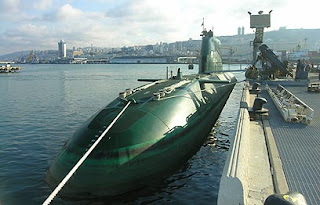A new nuclear submarine will be ready to test the next generation of intercontinental missiles this year, a military shipbuilding spokesman said Tuesday.
The Yury Dolgoruky, the first of the country's new Borei class of submarines, has yet to fire the Bulava missile it was made to carry because of numerous failures during testing.
"By the beginning of the navigation season, all ships will be ready to carry out tests of the Bulava," said Alexander Kholodov, a representative of submarine-building shipyard Sevmash.
"This refers above all to the submarines Dmitry Donskoi and Yury Dolgoruky," he said.
The Dmitry Donskoi is an older Akula-class vessel used for previous Bulava tests while Borei-class submarines were undergoing testing.
The Bulava was designed to be carried on submarines like the Yury Dolgoruky, but repeated failures of the missile during tests have called the costly project into question.
The submarine's entry into service, carrying the Bulava, will be a major step forward for the military, which hopes to use rising oil revenues to increase its clout.
The Yury Dolgoruky, the first of the country's new Borei class of submarines, has yet to fire the Bulava missile it was made to carry because of numerous failures during testing.
"By the beginning of the navigation season, all ships will be ready to carry out tests of the Bulava," said Alexander Kholodov, a representative of submarine-building shipyard Sevmash.
"This refers above all to the submarines Dmitry Donskoi and Yury Dolgoruky," he said.
The Dmitry Donskoi is an older Akula-class vessel used for previous Bulava tests while Borei-class submarines were undergoing testing.
The Bulava was designed to be carried on submarines like the Yury Dolgoruky, but repeated failures of the missile during tests have called the costly project into question.
The submarine's entry into service, carrying the Bulava, will be a major step forward for the military, which hopes to use rising oil revenues to increase its clout.










